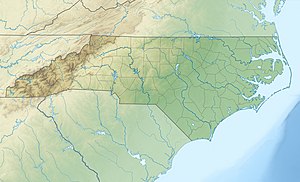| Dry Creek Tributary to Haw River | |
|---|---|
  | |
| Location | |
| Country | United States |
| State | North Carolina |
| County | Chatham |
| Physical characteristics | |
| Source | divide between Harlands Creek and Landrum Creek (Rocky River) |
| • location | about 4 miles south-southeast of Silk Hope, North Carolina |
| • coordinates | 35°44′39″N 079°21′10″W / 35.74417°N 79.35278°W / 35.74417; -79.35278 |
| • elevation | 630 ft (190 m) |
| Mouth | Haw River |
| • location | about 2 miles northwest of Bynum, North Carolina |
| • coordinates | 35°47′44″N 079°10′54″W / 35.79556°N 79.18167°W / 35.79556; -79.18167 |
| • elevation | 338 ft (103 m) |
| Length | 12.89 mi (20.74 km) |
| Basin size | 20.21 square miles (52.3 km) |
| Discharge | |
| • location | Haw River |
| • average | 24.47 cu ft/s (0.693 m/s) at mouth with Haw River |
| Basin features | |
| Progression | Haw River → Cape Fear River → Atlantic Ocean |
| River system | Haw River |
| Tributaries | |
| • left | Long Branch |
| • right | unnamed tributaries |
| Bridges | Harold Hackney Road, Bowers Store Road, Silk Hope Gum Springs Road, Graham Road (NC 87), Old Graham Road |
Dry Creek is a 12.89 mi (20.74 km) long 2nd order tributary to the Haw River in Chatham County, North Carolina.
Course
Dry Creek rises about 4 miles south-southeast of Silk Hope, North Carolina in Chatham County and then flows northeast to the Haw River upstream of Bynum.
Watershed
Dry Creek drains 20.21 square miles (52.3 km) of area, receives about 47.4 in/year of precipitation, and has a wetness index of 430.05 and is about 60% forested.
See also
References
- ^ "GNIS Detail - Dry Creek". geonames.usgs.gov. US Geological Survey. Retrieved 29 September 2019.
- ^ "Dry Creek Topo Map, Chatham County NC (Bynum Area)". TopoZone. Locality, LLC. Retrieved 29 September 2019.
- "ArcGIS Web Application". epa.maps.arcgis.com. US EPA. Retrieved 29 September 2019.
- ^ "Dry Creek Watershed Report". Waters Geoviewer. US EPA. Retrieved 29 September 2019.
Additional maps

